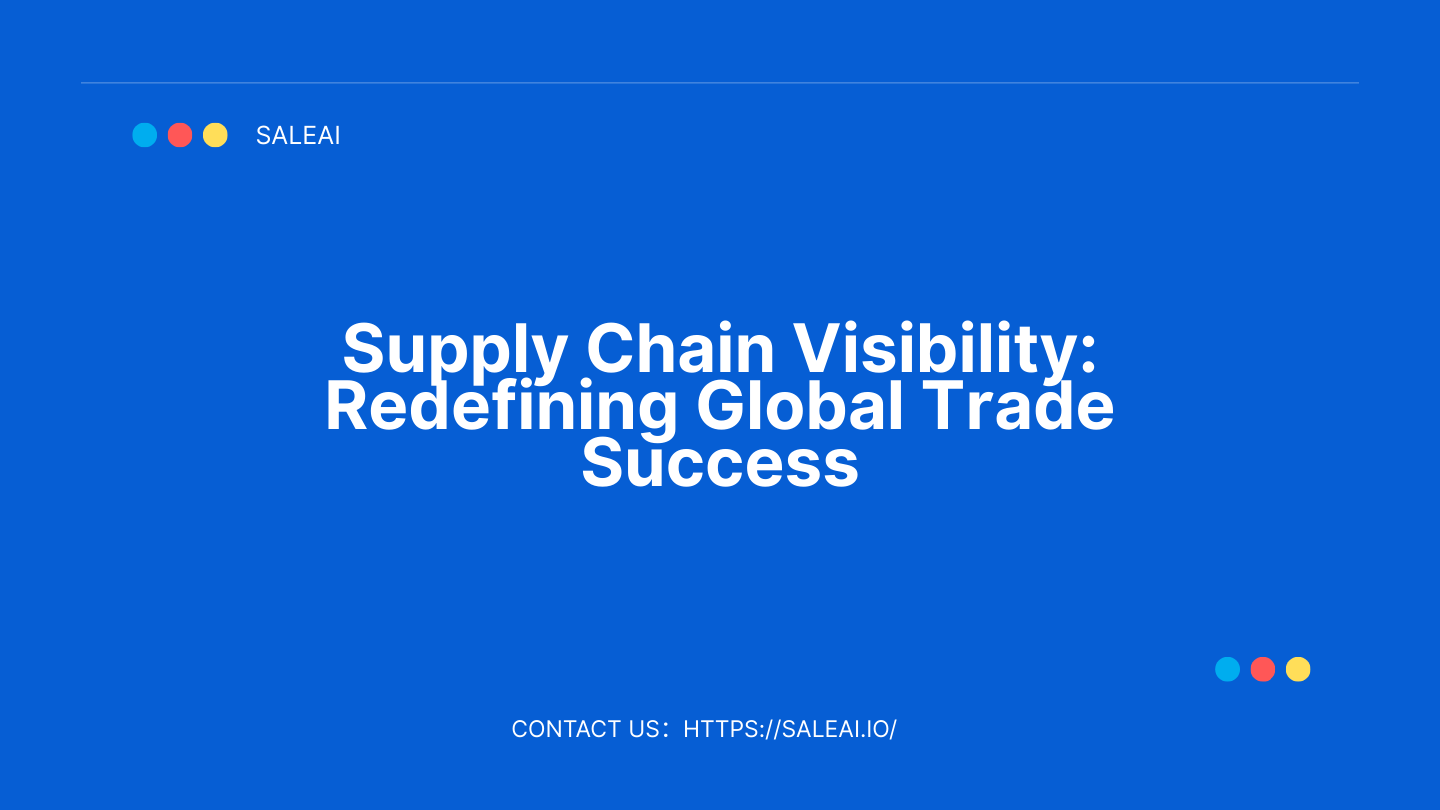The New Era of Supply Chain Visibility in Global Trade
In today’s highly interconnected world of global trade, supply chain visibility is no longer just an operational advantage—it’s a strategic necessity. Businesses that can track the flow of goods and data across their supply chains are better positioned to respond to disruptions, meet customer demands, and maintain a competitive edge.
The traditional, opaque supply chain model is quickly becoming obsolete. With advanced technologies like AI-driven analytics, real-time tracking, and data integration, companies can now achieve end-to-end supply chain visibility, transforming how they operate and compete globally.
This article will explore the importance of supply chain visibility, its impact on global trade, and how businesses can use tools like TradeLink AI by SaleAI to gain unparalleled transparency and control.
What is Supply Chain Visibility and Why Does It Matter?
At its core, supply chain visibility is the ability to track and monitor every aspect of your supply chain in real-time—from raw material sourcing to final delivery. It provides businesses with a clear view of:
- Shipment Locations and Status
- Inventory Levels Across Warehouses
- Supplier Performance Metrics
- Potential Disruptions or Delays
- Compliance and Documentation Status
Supply chain visibility matters because it enables businesses to:
- Respond Quickly to Disruptions: Minimize the impact of delays, bottlenecks, or unexpected events.
- Improve Customer Satisfaction: Provide accurate delivery timelines and faster service.
- Optimize Operations: Streamline processes, reduce costs, and improve efficiency.
- Enhance Risk Management: Identify and mitigate risks before they escalate.
In global trade, where supply chains span multiple countries, regions, and time zones, visibility is critical for maintaining resilience and agility.
The Challenges of Achieving Supply Chain Visibility
Despite its importance, achieving true supply chain visibility remains a challenge for many businesses. Key obstacles include:
a. Fragmented Systems
Global supply chains often involve multiple stakeholders—suppliers, manufacturers, logistics providers, and retailers—each using different systems and processes. This lack of integration creates blind spots.
b. Limited Real-Time Data
Many businesses still rely on outdated data that doesn’t reflect real-time conditions, leading to delayed responses and missed opportunities.
c. Unpredictable Disruptions
From natural disasters to geopolitical events, supply chain disruptions can occur anytime, making it difficult to maintain visibility and control.
d. Compliance Complexities
Navigating international trade regulations requires constant monitoring of documentation, tariffs, and compliance requirements, which can overwhelm businesses without the right tools.
e. Scalability Issues
As businesses grow and expand into new markets, maintaining visibility across a larger, more complex supply chain becomes increasingly difficult.
How Supply Chain Visibility is Redefining Global Trade
The shift towards greater supply chain visibility is transforming global trade in several ways:
a. Proactive Risk Management
With real-time insights into supply chain performance, businesses can identify risks early and take proactive measures to address them.
- Example: A technology company detects a delay in component shipments from Asia and secures an alternative supplier to avoid production halts.
b. Enhanced Customer Experience
Supply chain visibility enables businesses to provide customers with accurate delivery timelines, real-time tracking, and faster resolutions to issues.
- Example: An e-commerce retailer uses visibility tools to notify customers of delivery updates, improving satisfaction and loyalty.
c. Cost Optimization
By analyzing supply chain data, businesses can identify inefficiencies, reduce waste, and optimize routes, inventory, and resources.
- Example: A logistics provider reduces fuel costs by using real-time traffic data to optimize delivery routes.
d. Increased Agility in Market Response
Visibility allows businesses to adapt quickly to changes in demand, market conditions, or regulatory environments.
- Example: A fashion brand adjusts its supply chain to prioritize seasonal products based on real-time demand trends.
e. Improved Sustainability
Tracking supply chain activities helps businesses identify areas to reduce their environmental impact, such as optimizing energy use or minimizing waste.
- Example: A food exporter uses visibility tools to monitor and reduce carbon emissions along its supply chain.
Action Plan: Achieving Supply Chain Visibility
Step 1: Map Your Supply Chain
Identify all the key components of your supply chain, including suppliers, logistics providers, warehouses, and distribution centers.
Step 2: Integrate Your Data Systems
Use a centralized platform to integrate data from multiple systems and stakeholders, ensuring a unified view of your supply chain.
Step 3: Leverage Real-Time Tracking
Equip your supply chain with real-time tracking technologies, such as IoT sensors, GPS, and RFID, to monitor shipments and inventory.
Step 4: Monitor Key Metrics
Focus on metrics that matter most to your business, such as delivery times, inventory levels, supplier performance, and compliance rates.
Step 5: Use Predictive Analytics
Deploy AI-powered tools to forecast potential disruptions, optimize operations, and make data-driven decisions.
Step 6: Collaborate with Stakeholders
Work closely with suppliers, logistics partners, and other stakeholders to ensure transparency and alignment across the supply chain.
How SaleAI’s TradeLink AI Enhances Supply Chain Visibility
TradeLink AI by SaleAI provides businesses with the tools they need to achieve full supply chain visibility and take control of their global trade operations.
Key Features Include:
- Real-Time Shipment Tracking: Monitor the status and location of shipments across 130+ countries.
- Supplier Performance Insights: Evaluate supplier reliability using data-driven analytics.
- Integrated Data Systems: Consolidate trade, logistics, and inventory data into a single, easy-to-use platform.
- Predictive Alerts: Receive notifications about potential disruptions, delays, or compliance issues.
- Customizable Dashboards: Focus on the metrics that matter most to your business, from delivery times to cost efficiency.
Why Choose TradeLink AI?
- Actionable Insights: Turn raw supply chain data into meaningful recommendations.
- Scalable Solutions: Adaptable to businesses of all sizes, from small exporters to multinational corporations.
- Simplified Compliance: Stay updated on global trade regulations and ensure smooth operations.
The Future of Supply Chain Visibility
As technology continues to advance, the future of supply chain visibility is poised to bring even greater benefits to businesses:
- AI-Powered Decision-Making: AI will play an even larger role in analyzing supply chain data and providing predictive recommendations.
- Blockchain for Transparency: Blockchain technology will enhance data security, accuracy, and trust across supply chains.
- IoT Integration: The Internet of Things (IoT) will enable real-time tracking of goods at every stage of the supply chain.
- Collaborative Platforms: Businesses will increasingly use shared platforms to improve collaboration and data sharing with supply chain partners.
By embracing these innovations, businesses can create more resilient, efficient, and customer-focused supply chains.
Conclusion: Visibility is the Future of Global Trade
In the fast-paced world of global trade, supply chain visibility is no longer optional—it’s a competitive necessity. Businesses that achieve end-to-end transparency can respond faster to disruptions, optimize operations, and deliver better outcomes for their customers.
With TradeLink AI by SaleAI, businesses gain access to advanced tools that simplify supply chain management and provide actionable insights. Whether you’re tracking shipments, evaluating supplier performance, or ensuring compliance, TradeLink AI empowers you to succeed in today’s complex global trade environment.



